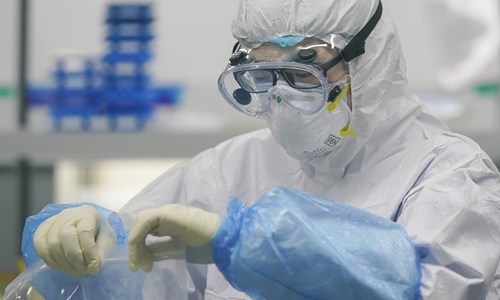Change in severe COVID-19 patient's serum can predict disease development: Chinese scientists
By Zhang Han Source:Global Times Published: 2020/6/1 13:03:24

A staff member handles testing samples at a novel coronavirus detection lab in Wuhan, central China's Hubei Province on Feb. 22, 2020.Photo:Xinhua
Chinese scientists have found multiple molecular changes and biological indicators of such changes in the serum of severe COVID-19 patients, which could be used to predict how the disease develops in patients.
There have been millions of infections worldwide so far, but our knowledge of the disease is far richer in clinical symptoms and medical imaging results than in micro molecular level changes, team leader Guo Tiannan told the Global Times on Monday.
Guo is also a research fellow with the School of Life Sciences at Westlake University, which is China's first research-oriented university that is funded by private sources, including Tencent Holdings Ltd Chairman Pony Ma Huateng.
Guo's team, together with other research teams, analyzed 99 serum samples from healthy people, people with flu showing coronavirus symptoms, mild COVID-19 patients and severe patients.
Researchers used high-resolution mass spectrometry equipment and machine learning methods to obtain the proteome and metabolome spectra of the serum samples, and performed a panoramic determination of the relative concentrations of proteins and metabolites in the samples, revealing unique molecular regulation in the bodies of severe patients.
Mass spectrometry found that in severe COVID-19 patients' serum, 93 proteins show different expression and 204 metabolites also changed in correlation with the severity of the disease.
In a bid to identify severe cases from all coronavirus patients, the team built a machine learning model based on proteomic and metabolomic data of 18 non-severe and 13 severe patients. The model prioritized 22 proteins and seven metabolites that could be serum indicators of severe patients.
Pathway analysis also highlighted metabolic and immune dysregulation in COVID-19 patients.
The study shows that it is possible to use serum protein and metabolite biomarkers to predict who is developing into a severe patient, Guo said, noting the research data also reveals the molecular pathophysiology of COVID-19, which is expected to help develop anti-coronavirus therapy.
Results of the study have been published pre-proof in prestigious life sciences journal Cell.
Since China does not have many severe patients, the study may need further verification by independent research teams overseas. If proved accurate on a larger scale, the result would be useful in helping diagnose patients and develop therapies, he said.
China had three active severe COVID-19 patients as of Monday, according to the National Health Commission.
Posted in: SOCIETY